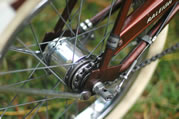Derailleurs, internal gear hubs and the transport cyclist
Derailleur: French for 'disposable'?
This may be of interest if you've recently joined the legions of new cyclists who ride for commuting or errands. If so, your bike is probably fitted with a derailleur, a device that moves the chain from one sprocket to another to change gears. Most new bikes have a derailleur, and you, being new to the game, could be forgiven for thinking that's the only way to change gears. However, in times past there was another way, a way that's relatively clean and civilised – the 'internal gear hub'. With the resurgence in transport cycling, perhaps that time is returning.
the only way to change gears. However, in times past there was another way, a way that's relatively clean and civilised – the 'internal gear hub'. With the resurgence in transport cycling, perhaps that time is returning.
What's in the box?
As the name suggests, the gear mechanism of an internal gear hub (IGH) is enclosed within the (rear) hub. There's little to indicate what's in there or how it works – all one sees is just a shiny hub with a sprocket attached and a funny little chain, cable or somesuch. But within lurks a marvel of mechanical ingenuity, one that links the sprocket to the hub shell in a different way for each gear. This is achieved by means of the epicyclic principle, which employs gears revolving within gears, the sort of thing used in most motor vehicle automatic transmissions and many other applications.
The rise and fall of the internal gear hub
IGHs were first made in the early 20th century by Sturmey Archer. They were a costly investment, but for most cyclists in most places (yes, the French are different), their three speed IGH became the Gold Standard for generations. In contrast, sprocket shifting systems, such as derailleurs, were a popular choice for the go-fast brigade. Sturmey Archer was long the biggest name in internal hub gears, but there were also Fichtel and Sachs, Bendix and others. Sturmey Archer is still in the business, as are Shimano and Rohloff. Sadly, in February 2017 SRAM (which took over Fichtel and Sachs) announced it was withdrawing from the IGH market.
IGHs fell out of favour in many countries during the 1970s as derailleurs improved and fewer bikes were used for everyday transport. While some sensible souls bought a shopper bike, with an internal hub gear, most cyclists were more intent on emulating champion racers like Eddy Merckx on a fashionable ten-speed racing style bike. That style required front and rear derailleurs, and racy looks, but not the mudguards, chainguard, bell, or sidestand cyclists previously took for granted. The typical bike had morphed from being a vehicle to a fun machine. And, uncoincidentally, it was somewhat cheaper to make…
Which is where The Contemporary Bike comes in. For all the proliferation of styles and designs currently available, in concept the  typical new bike is closer to the 70s 10 speed ‘racing’ bike than the practical ‘transport’ bikes of yore. Not that there’s anything wrong with that – as long as that bike isn't intended for everyday, all-weather transport. This is a shame, as more and more folk are trying cycling for that very purpose; they walk into a bike shop looking for a transport bike but are instead foisted a machine designed for recreational use, whether that be road racing, tooling around the park or exploring bush trails.
typical new bike is closer to the 70s 10 speed ‘racing’ bike than the practical ‘transport’ bikes of yore. Not that there’s anything wrong with that – as long as that bike isn't intended for everyday, all-weather transport. This is a shame, as more and more folk are trying cycling for that very purpose; they walk into a bike shop looking for a transport bike but are instead foisted a machine designed for recreational use, whether that be road racing, tooling around the park or exploring bush trails.
Derailleurs couldn't be too bad – could they?
And the chief offender in all this is the derailleur, with a gear for any occasion; the highest high, the lowest low, many in between, some yet undiscovered, and all for less than the cost of an IGH – a triumph of value engineering, and a marketer's dream.
And what's wrong with derailleurs? Well, (apart from them being generally filthy, horrible things) it usually doesn’t take too long to find out; one day, just a little after the newness of a bike begins to fade, the chain will make a bid for freedom and in so doing jam itself in the nether regions of the frame. A few minutes and some grubby fingers later, one is back on the road until it happens again. And between derailings the rear-end filth accumulates as the efficiency recedes, with the occasional graunch to enliven proceedings.
The rider won't worry about this too much and carry on. However, the derailings gradually become more frequent and, sooner or later, the shaggy dog machine will end up at the local bike shop for a new chain and cassette.
IGHs aren’t like that. They don't require day-to-day maintenance, just a major service at the bike shop every few years, or (for the old ones) a squirt of oil every so often. In the interim, they just work; the chain never comes off, they don’t graunch, the shifting remains precise and the whole thing is easy to keep clean.
How can one possibly live with fewer than 27 gears?
IGHs have from two to 14 gears, so if you're used to a derailleur you may be wondering how one can get by with so few. The short answer is that, for the average around town cyclist, derailleurs are overkill. A longer answer would note that many of the gears are too closely spaced, some front/rear combinations are unusable, several of the gears (across the two or three ranges) are near duplicates, and the lowest and highest gears are superfluous. In the real world, the rider of a derailleur-equipped bicycle would probably need just a small selection of the available gears, 99% of the time.
Derailleur systems with 27 gears, often fitted to off-road-style bikes, commonly have a range of over 500%. This means that in the  highest gear the bike travels more than five times as far per pedal stroke as it does in the lowest gear. In contrast, a three speed IGH offers a range of around 175%. Other popular IGHs have five, seven or eight speeds, with a range from around 200% to 325%. At the upper (and quite pricey) end of the scale are the Shimano 11 speed, with a range of 409%, and the Rohloff Speedhub, with 14 speeds and a derailleur-style 526%.
highest gear the bike travels more than five times as far per pedal stroke as it does in the lowest gear. In contrast, a three speed IGH offers a range of around 175%. Other popular IGHs have five, seven or eight speeds, with a range from around 200% to 325%. At the upper (and quite pricey) end of the scale are the Shimano 11 speed, with a range of 409%, and the Rohloff Speedhub, with 14 speeds and a derailleur-style 526%.
You might have noticed the 14 speed Rohloff has a large number of gears for its range compared to a three speed (i.e. 14:526 compared to 3:175). This is because the 14 gears in the Rohloff are closely spaced and those in the three speed are spread much further apart. Large gaps are undesirable because the rider may sometimes find one gear too low and the next one up too high. Having said that, it is worth keeping in mind that millions of cyclists the world over use three speeds every day without giving such things a thought.
So how many gears do you need? Well, the Rohloff, with its 14 speeds may be impressive, but for most transport cyclists a humble three speed is probably sufficient. For those of us in hilly country an eight speed may be the ticket. And whatever the number of gears, they are easy to use, as they are in numerical sequence from bottom to top, with no chopping and changing as there is with derailleurs.
Efficiency: Internal gear hubs vs derailleurs
IGH systems are commonly criticised for being less mechanically efficient than derailleurs. The reasoning is that too much of the power produced by the rider is lost as it passes through numerous gears before being applied to turning the back wheel.
rider is lost as it passes through numerous gears before being applied to turning the back wheel.
Well, that reasoning may apply to laboratory testing conditions, but not so real life. The theoretical difference in efficiency is very small (if it exists at all), and that tiny amount, whatever it is, is more than negated by the harsh realities of mud, dust, rain, less-than-scrupulous maintenance and any number of other real-life factors. Derailleur transmissions are only briefly at their best – few riders are willing to give them the maintenance needed to keep them that way (Tour de France competitors have a van following…). Meanwhile, IGHs just keep on working.
And this is what it all boils down to: Imagine you're a bicycle manufacturer and you're deciding whether to equip your new model with a 27 speed derailleur or an eight speed IGH, which costs more and, on paper, offers less. Which would be easier to sell, and which would have the higher margin? A no-brainer indeed. But what about the customer who's looking for practical transport, day in, day out, rain or shine? If the customer knows no better, he or she will very likely be steered towards a derailleur-equipped bike.
Would that be you?
Further reading: So you want to ride to work… (aka taking the wind out of the sails of those considering cycle commuting)
